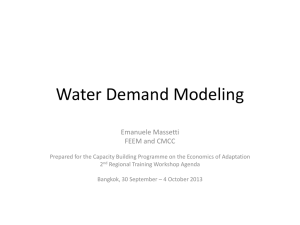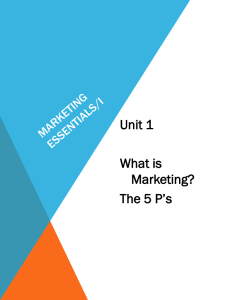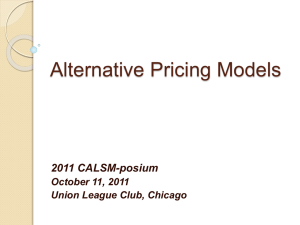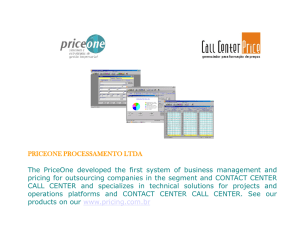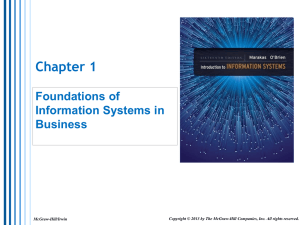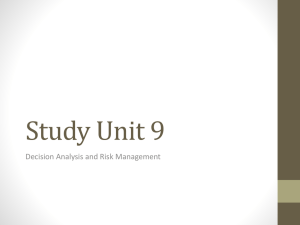NLP Research Presentation
advertisement
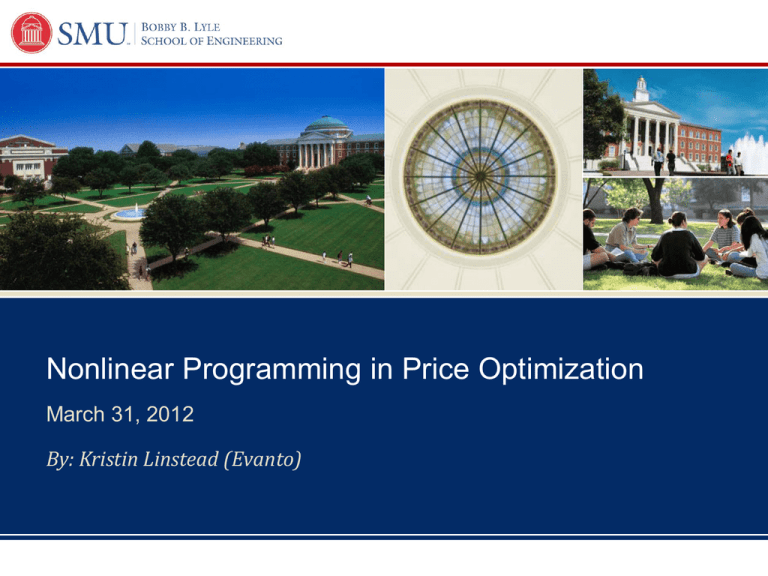
Nonlinear Programming in Price Optimization March 31, 2012 By: Kristin Linstead (Evanto) Outline I. “Real World” Application / Importance of Optimal Pricing II. The Basic Price Optimization Problem III. Small-Scale Example of Price Optimization IV. Optimality Conditions V. Pricing Case Study VI. Appendix 2 Outline I. “Real World” Application / Importance of Optimal Pricing II. The Basic Price Optimization Problem III. Small-Scale Example of Price Optimization IV. Optimality Conditions V. Pricing Case Study VI. Appendix 3 Dynamic pricing has become integral to the practice in the optimization / OR space • “The better management of pricing is the fastest and most cost-effective way to increase profits…a 1% improvement in price creates an operating profit improvement of 11.1%” – McKinsey & Company • “The CRM industry…[is] beginning to devote more resources to price optimization...Gartner MarketScope estimates the total worldwide revenue of the market for B2B pricing software at $150 million as of 2007, and it’s growing at 30% per year” – CRM Magazine • Industries highly susceptible to pricing pressure: cargo & freight, entertainment & leisure, hospitality, media, and passenger travel industries – American Airlines case study: the 1980’s price war against PeopleExpress – Revenue Management = special case of pricing problem with constrained supply – Price controls can be used dynamically to limit access to available seats 4 The list of potential objectives for a pricing problem is endless… • Maximize total contribution • Survival • Maximize revenue • Avoid government investigation / intervention • Maximize long-run / long-run profit • • Increase sales volume (quantity) Obtain or maintain the loyalty and enthusiasm of distributors and other sales personnel • Increase monetary sales • • Increase market share Enhance the image of the firm, brand or product • Obtain a target rate of return on investment • • Be perceived as “fair” by customers and potential customers Obtain a target rate of return on sales • • Create interest and excitement about a product Stabilize market or stabilize market price • • Discourage competitors from cutting prices Company growth • • Use price to make the product “visible” Maintain price leadership • • Build store traffic Desensitize customers to price • • Discourage new entrants into the industry Help prepare for the sale of the business (harvesting) • Match competitors prices • Social, ethical, or ideological objectives • Encourage the exit of marginal firms from the industry • Gain a competitive advantage 5 Outline I. “Real World” Application / Importance of Optimal Pricing II. The Basic Price Optimization Problem III. Small-Scale Example of Price Optimization IV. Optimality Conditions V. Pricing Case Study VI. Appendix 6 The Basic Price Optimization Problem “In English”: Total Contribution(1) = Unit Margin(2) × Demand for the product of a single seller as a function of the price offered by that seller(3) Definitions: 1) Total Contribution = m(p) = Sum of the margins of all products sold during a time period 2) Unit Margin = (p – c) = Difference between the price at which a product is sold and its incremental cost 3) Price-Response Function = d(p) = specifies how demand for a product varies as a function of price Mathematical Equation: m(p) = (p – c) × d(p) 7 The Price-Response Function…where nonlinearity comes into play! • There is one price-response curve associated with each combination of product, market segment, and channel that relates price to demand – Companies competing in the same market can have vastly different priceresponse curves – In a perfectly competitive market, the price-response face by an individual seller is a vertical line at market price (highly elastic demand) 8 The Price-Response Function (cont’d) • Properties / Assumptions: – Nonnegative – Continuous – Differentiable – Downward sloping whenever d(p) > 0 (does not always hold) • Common Price-Response Functions: Linear: d(p) = D - mp Constant-Elasticity: d(p) = Cp-e Ce-(a+bp) Logit: d(p) = 1+ e-(a+bp) 9 The Pricing Objective Function (Unconstrained) Maximize: m(p) = (p – c) × d(p) p* is the price that maximizes total contribution This curve represents the maximum total contribution the supplier can realize in the current time period 10 We can now use standard optimization theory to evaluate the objective function 1. Take the derivative of our objective function with respect to price: m¢(p) = d¢(p)(p - c)+ d(p) 2. Set the derivative equation equal to zero 0 = d¢(p)(p - c)+ d(p) 3. The price that solves the equation will maximize total contribution d(p*) = -d¢(p*)(p*-c) 11 Outline I. “Real World” Application / Importance of Optimal Pricing II. The Basic Price Optimization Problem III. Small-Scale Example of Price Optimization IV. Optimality Conditions V. Pricing Case Study VI. Appendix 12 Example: Widget-making A widget maker is looking to set the price of widgets for the current month. Assume that the widget maker’s unit production cost c is a constant $1 per widget and that his demand for the current month is governed by the linear price-response function: d(p) = (10 – 2p) What is the objective function that will maximize total contribution? Maximize -2p2 + 12p – 10 What is the equation that will be solved with optimal price, p*? 10 – 2p* = 2(p* – 1) What is p*? p* = 3 Note: All numbers in 00’s 13 Outline I. “Real World” Application / Importance of Optimal Pricing II. The Basic Price Optimization Problem III. Small-Scale Example of Price Optimization IV. Optimality Conditions V. Pricing Case Study VI. Appendix 14 We can derive three equivalent optimality conditions using equation: d(p*) = -d¢(p*)(p*-c) 1. Marginal Price = Marginal Cost p* d¢(p*)+ d(p*) = cd¢(p*) – Marginal Revenue (L.H.S. of equation) – additional revenue the seller could achieve from a small increase in price • Derivative of total revenue with respect to price • Positive at low prices but negative at high prices – Marginal Cost (R.H.S. of equation) – additional cost the seller would incur from a small increase in price • Always ≤ 0 – Total contribution is maximized at p* where marginal revenue = marginal cost – Example: Key Take Away: If marginal revenue > marginal cost, the supplier can increase contribution by increasing price (and vice versa) 15 Optimality Conditions (cont’d) 2. If the point elasticity at our current price is < 1, we can increase total contribution by increasing price m¢(p) = d(p) [1- e (p)] - d¢(p)c – If d(p) > 0, then m’(p) will always be > 0 if ε(p) < 1 – Holds true until we reach a point where lost sales outweigh increased unit margins 3. Point elasticity Always ≥ 0 because d’(p) ≤ 0 At optimum price (p*), the contribution margin ratio is equal to the p* reciprocal of elasticity e (p*) = ( p *-c) ( p - c) – The quantity is known as the contribution margin ratio p 1 – At p*, price elasticity = contribution margin ratio Any of the three optimality conditions can be used to compute the optimal price; however, they may not hold if the price optimization is constrained 16 Outline I. “Real World” Application / Importance of Optimal Pricing II. The Basic Price Optimization Problem III. Small-Scale Example of Price Optimization IV. Optimality Conditions V. Pricing Case Study VI. Appendix 17 Pricing Case Study • Background − Company A is a global energy provider specializing in uranium enrichment − Marginal producer in market (high costs, low profit) • Analysis − Global estimation of demand levels of nuclear reactors − Looked at historical prices and how price performs given supply/demand balance • Findings − Demand increasing, but finite supply – Company A controls the US market − Company A set the market clearing price because they were the most expensive − Win-win for all companies in the global market 18 Outline I. “Real World” Application / Importance of Optimal Pricing II. The Basic Price Optimization Problem III. Small-Scale Example of Price Optimization IV. Optimality Conditions V. Pricing Case Study VI. Appendix 19 Alternative Objective Functions 1. Maximize Revenue – Objective function: Maximize d(p) p – Take derivative and set equal to zero: R¢( p) ˆ = d¢( p) ˆ pˆ + d( p) ˆ =0 – pˆ = revenue-maximizing price – This implies that pˆ solves: – We already learned that: ˆ pˆ d ¢( p) ˆ =1 = e ( p) ˆ d( p) Elasticity of priceresponse function • Total contribution is maximized when marginal revenue = marginal cost… • …and when marginal revenue = 0 • Therefore, the revenue-maximizing pˆ is lower than the contribution-maximizing p* 20 Alternative Objective Functions (cont’d): Maximizing-Revenue Example The CEO of widget-making company decides that the firm’s goal for the next month will be to maximize revenue from widget sales as part of the long-term strategy to increase market share. d(p) = (10 – 2p) What is the equation that will be solved with optimal price, pˆ ? -4 pˆ +10 = 0 What is pˆ ? pˆ = 2.50 Note: All numbers in 00’s 21 Alternative Objective Functions (cont’d) 2. Maximize weighted combination of revenue and contribution – Most common approach is applying a weighting parameter: 0 < α < 1 – Objective function: Z(p) = a (p - c)d(p)+ (1- a )pd(p) – “Maximizing contribution with a discounted cost” Weighted Combination (Revenue & Revenue-Maximizing Contribution-Maximizing ≤ ≤ Contribution) Price ( pˆ ) Price ( p *) Maximizing Price 22 Sources 1. Phillips, Robert. Pricing and Revenue Optimization. Stanford: Stanford University Press, 2005. Print. 2. Lagar, Marshall. "The Price is Right...You Hope." CRM Magazine. October 2008. Web. 22 March 2012. <http://www.destinationcrm.com/Articles/Editorial/Magazine-Features/The-Pr Is-Right...You-Hope-50751.asp&xgt;. 3. “Pricing Objectives.” Wikipedia. Web. 23 March 2012. <http://en.wikipedia.org/wiki/Pricing_objectives>. 4. Taylor & Francis Group. Edited by A. Ravi Ravindran. Operations Research Applications. Boca Raton: CRC Press, 2009. Print. [Originally printed in Operations Research and Management Science Handbook (2008)]. 5. “Pricing and Revenue Optimization – Driving Value from CRM Investments.” Pricing Society. Web. 23 March 2012. <http://members.pricingsociety.com/articles/pricing-and-revenueoptimization-driving-value-from-crm-investments.pdf>. 23

